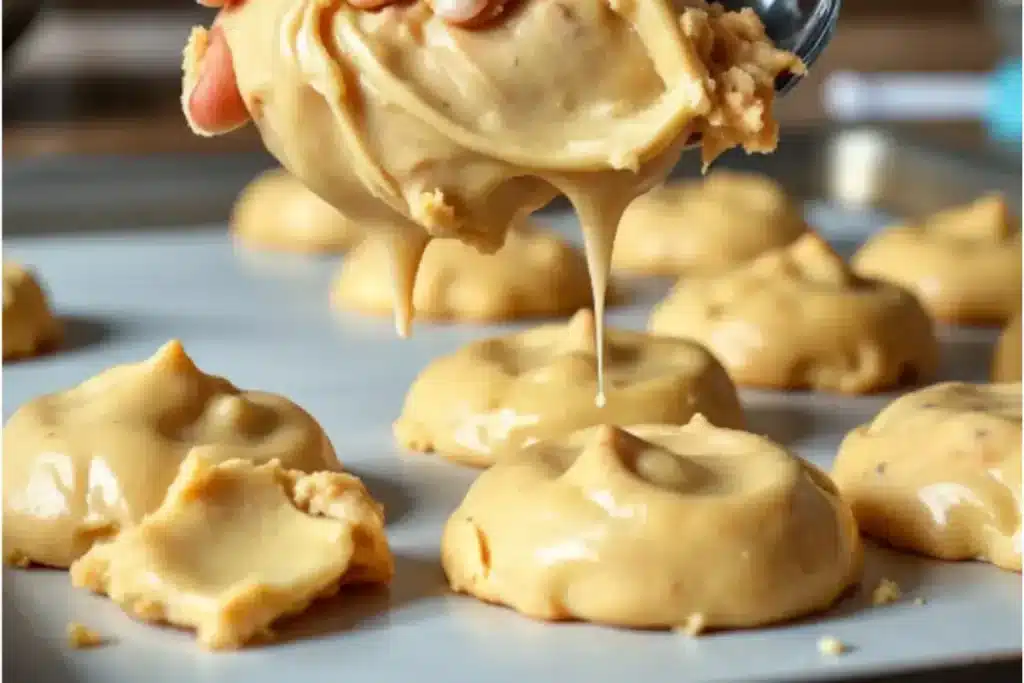Cake mix cookies have become a popular dessert choice for home bakers due to their simplicity and delicious results. However, a common issue many face is dealing with sticky dough, making the process frustrating and difficult. If you’ve ever asked yourself, “Why are my cake mix cookies so sticky?”, you’re not alone!
Sticky dough can make it hard to shape cookies, lead to uneven baking, and impact the final texture. This comprehensive guide explores the reasons behind sticky dough and offers practical solutions to ensure your cookies turn out perfect every time.
Table of Contents
Understanding the Ingredients in Cake Mix Cookies 🧪
To fix sticky dough, it’s essential to understand the key ingredients in cake mix cookies. These cookies require only a few ingredients, making them a convenient quick-baking choice, but the balance of these ingredients affects dough consistency.
Key Ingredients:
- Cake Mix – Provides flour, sugar, leavening agents, and flavor.
- Eggs – Add moisture and act as a binding agent.
- Oil or Butter – Contributes fat, impacting texture and richness.
- Mix-Ins (chocolate chips, nuts, fruit) – Enhance flavor but can add extra moisture.
A wet-to-dry ratio imbalance can lead to sticky dough, making it difficult to manage. If there’s too much moisture from eggs, oil, or mix-ins, your dough may become overly sticky.
For perfectly balanced dough, check out our Baking Measurement Guide for accurate ingredient proportions. 📏
Common Reasons Why Cake Mix Cookies Are Sticky 🤔

1. Too Much Moisture in the Dough 💦
Excessive moisture is the most common reason for sticky dough:
- Too many eggs – Large eggs or adding an extra egg can create excess moisture.
- Too much oil – Extra oil makes the dough overly wet.
- High-moisture mix-ins – Fresh fruit, marshmallows, or melty chocolate add extra moisture.
🛠 Fix: Try using medium-sized eggs and measure oil precisely.
2. Overmixing the Dough 🌀
Overmixing can activate gluten, leading to a dense, sticky texture:
- Too much air = a weaker dough structure.
- Gluten development = tougher dough and sticky handling.
🛠 Fix: Mix until just combined—avoid overworking the dough.
3. Humidity & Warm Kitchen Temperatures 🌡️
Baking in a humid or warm environment introduces extra moisture:
- Humidity makes dry ingredients absorb moisture, resulting in sticky dough.
- Warm kitchens cause butter/oil to soften too much, making dough hard to handle.
🛠 Fix: If it’s humid, chill the dough before handling.
For more humidity-baking hacks, check out How to Bake in Humid Conditions guide! 🌧️
How to Prevent Sticky Dough in Cake Mix Cookies 🍪

1. Adjust Wet & Dry Ingredients 📏
- Add a tablespoon of flour or cake mix at a time until the dough firms up.
- Reduce oil or eggs slightly if dough feels overly wet.
2. Chill the Dough Before Baking ❄️
- Refrigerate for 30-60 minutes before rolling dough.
- Overnight chilling results in better texture and easier handling.
3. Use Parchment Paper or Silicone Mats 🧑🍳
- Prevents dough from sticking to the pan.
- Helps cookies bake evenly and improves texture.
4. Flour or Sugar Rolling Method 🍚
- Lightly dust your hands and tools with flour before shaping dough.
- Roll cookie dough balls in powdered sugar for a crinkle effect and easier handling.
Troubleshooting Sticky Dough: Quick Fixes 🛠️

1. Flouring Your Hands & Tools ✋
- Lightly dust hands and tools with flour or powdered sugar before handling dough.
2. Baking at the Right Temperature 🔥
- Ensure your oven is fully preheated (350°F / 175°C is standard for cake mix cookies).
- Oven too hot? Cookies may spread too much, leading to stickier dough.
3. Using a Cookie Scoop 🥄
- Prevents dough from sticking to your hands.
- Ensures even-sized cookies for uniform baking.
How Different Cake Mix Flavors Affect Dough Stickiness 🎂
Not all cake mixes behave the same! Different flavors impact dough moisture levels:
High-Moisture Cake Mixes (More Sticky Dough):
- Chocolate Cake Mix – Cocoa powder absorbs moisture, making the dough stickier.
- Red Velvet Cake Mix – Additional food coloring and cocoa increase moisture.
- Carrot Cake Mix – Extra spices and ingredients can create a wet dough.
Lower-Moisture Cake Mixes (Easier to Handle Dough):
- Vanilla Cake Mix – Typically drier, making for an easier-to-handle dough.
- Lemon Cake Mix – Lighter texture with less moisture.
🛠 Fix: If using a moist cake mix, add 1-2 tablespoons of extra flour or chill the dough longer.
For more flavor variations, check out our Cake Mix Cookie Flavor Guide! 🍰
Sticky cake mix cookie dough can be frustrating, but with the right techniques and adjustments, you can easily fix it. Whether it’s adjusting wet-to-dry ingredients, chilling the dough, or using flouring techniques, small changes make a big difference!
Try these tips next time you bake, and enjoy perfectly shaped, delicious cookies every time! 🍪✨
FAQs ❓
Why is my cake mix cookie dough so sticky?
- Too much moisture, overmixing, or high humidity can lead to sticky dough. Adjusting wet ingredients and chilling the dough can help!
Can I fix sticky dough after mixing?
- Yes! Add a small amount of flour or cornstarch, chill the dough, or roll it in powdered sugar before baking.
Should I always chill cake mix cookie dough?
- Yes, especially if it’s warm or humid. 30 minutes in the fridge firms up dough, making it easier to handle and shape.
What’s the best way to store cake mix cookies?
- Keep cookies in an airtight container at room temperature for up to 7 days or freeze for up to 3 months.


2 thoughts on “Why Are My Cake Mix Cookies So Sticky?”